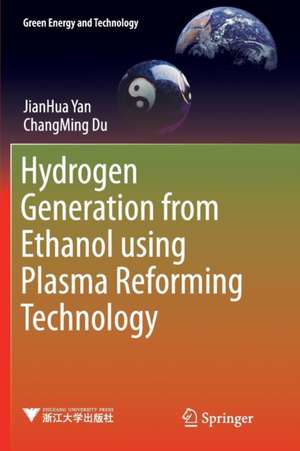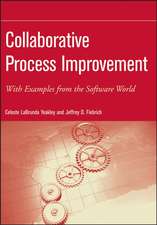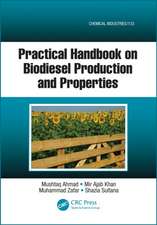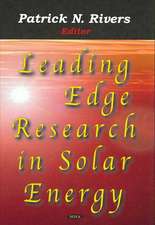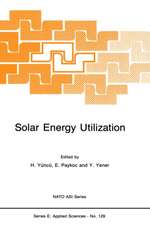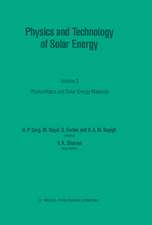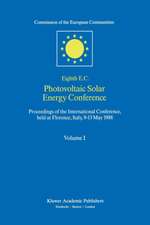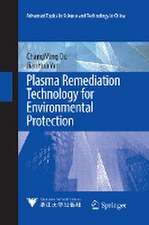Hydrogen Generation from Ethanol using Plasma Reforming Technology: Green Energy and Technology
Autor JianHua Yan, ChangMing Duen Limba Engleză Paperback – 4 mai 2018
| Toate formatele și edițiile | Preț | Express |
|---|---|---|
| Paperback (1) | 631.40 lei 6-8 săpt. | |
| Springer Nature Singapore – 4 mai 2018 | 631.40 lei 6-8 săpt. | |
| Hardback (1) | 637.46 lei 6-8 săpt. | |
| Springer Nature Singapore – 21 mar 2017 | 637.46 lei 6-8 săpt. |
Din seria Green Energy and Technology
- 18%
 Preț: 943.43 lei
Preț: 943.43 lei - 20%
 Preț: 629.52 lei
Preț: 629.52 lei - 18%
 Preț: 1124.92 lei
Preț: 1124.92 lei - 18%
 Preț: 947.35 lei
Preț: 947.35 lei - 15%
 Preț: 655.92 lei
Preț: 655.92 lei - 18%
 Preț: 957.62 lei
Preț: 957.62 lei - 18%
 Preț: 789.52 lei
Preț: 789.52 lei - 17%
 Preț: 464.56 lei
Preț: 464.56 lei - 15%
 Preț: 645.79 lei
Preț: 645.79 lei - 18%
 Preț: 903.93 lei
Preț: 903.93 lei - 24%
 Preț: 1322.09 lei
Preț: 1322.09 lei - 18%
 Preț: 890.54 lei
Preț: 890.54 lei - 18%
 Preț: 1115.46 lei
Preț: 1115.46 lei - 18%
 Preț: 1117.03 lei
Preț: 1117.03 lei - 18%
 Preț: 949.73 lei
Preț: 949.73 lei - 18%
 Preț: 892.11 lei
Preț: 892.11 lei - 15%
 Preț: 648.24 lei
Preț: 648.24 lei - 18%
 Preț: 997.09 lei
Preț: 997.09 lei - 15%
 Preț: 579.81 lei
Preț: 579.81 lei - 18%
 Preț: 1123.15 lei
Preț: 1123.15 lei - 18%
 Preț: 961.41 lei
Preț: 961.41 lei - 17%
 Preț: 490.23 lei
Preț: 490.23 lei - 18%
 Preț: 904.60 lei
Preț: 904.60 lei - 15%
 Preț: 643.34 lei
Preț: 643.34 lei -
 Preț: 287.91 lei
Preț: 287.91 lei - 24%
 Preț: 634.05 lei
Preț: 634.05 lei -
 Preț: 379.40 lei
Preț: 379.40 lei - 18%
 Preț: 783.20 lei
Preț: 783.20 lei - 18%
 Preț: 1394.84 lei
Preț: 1394.84 lei - 18%
 Preț: 1691.57 lei
Preț: 1691.57 lei - 18%
 Preț: 1112.48 lei
Preț: 1112.48 lei - 15%
 Preț: 592.61 lei
Preț: 592.61 lei - 18%
 Preț: 952.09 lei
Preț: 952.09 lei - 18%
 Preț: 944.19 lei
Preț: 944.19 lei - 18%
 Preț: 891.33 lei
Preț: 891.33 lei - 18%
 Preț: 1252.44 lei
Preț: 1252.44 lei - 18%
 Preț: 789.52 lei
Preț: 789.52 lei - 20%
 Preț: 566.30 lei
Preț: 566.30 lei - 18%
 Preț: 1113.71 lei
Preț: 1113.71 lei - 18%
 Preț: 1114.24 lei
Preț: 1114.24 lei - 24%
 Preț: 590.60 lei
Preț: 590.60 lei - 20%
 Preț: 567.50 lei
Preț: 567.50 lei - 24%
 Preț: 907.50 lei
Preț: 907.50 lei - 18%
 Preț: 952.89 lei
Preț: 952.89 lei - 18%
 Preț: 952.89 lei
Preț: 952.89 lei - 18%
 Preț: 950.52 lei
Preț: 950.52 lei
Preț: 631.40 lei
Preț vechi: 742.82 lei
-15% Nou
Puncte Express: 947
Preț estimativ în valută:
120.83€ • 125.69$ • 99.76£
120.83€ • 125.69$ • 99.76£
Carte tipărită la comandă
Livrare economică 14-28 aprilie
Preluare comenzi: 021 569.72.76
Specificații
ISBN-13: 9789811099342
ISBN-10: 9811099340
Ilustrații: XI, 99 p. 23 illus.
Dimensiuni: 155 x 235 mm
Greutate: 0.17 kg
Ediția:Softcover reprint of the original 1st ed. 2017
Editura: Springer Nature Singapore
Colecția Springer
Seria Green Energy and Technology
Locul publicării:Singapore, Singapore
ISBN-10: 9811099340
Ilustrații: XI, 99 p. 23 illus.
Dimensiuni: 155 x 235 mm
Greutate: 0.17 kg
Ediția:Softcover reprint of the original 1st ed. 2017
Editura: Springer Nature Singapore
Colecția Springer
Seria Green Energy and Technology
Locul publicării:Singapore, Singapore
Cuprins
What is plasma reforming?.- Sources of plasma used in alcohols reforming.- Influencing factors on alcohols plasma reforming.- Types of Plasma-catalytic used in alcohols reforming.- Hydrogen from ethanol by a plasma reforming system.- Hydrogen from ethanol by a miniaturized plasma reforming system.- Hydrogen from ethanol by a miniaturized plasma-catalytic reforming system.- Hydrogen from ethanol by microplasma reforming system.- Mechanism of alcohols plasma reforming.- Models of alcohols plasma reforming for hydrogen production.- Discussion on alcohols plasma reforming.- Outlook.
Notă biografică
Prof. JianHua Yan is currently Vice President and Professor at Zhejiang University. He was born in June 1962 in Ningbo, Zhejiang Province. He graduated from Zhejiang University and completed his bachelor, master and PhD degrees in 1982, 1985 and 1990, respectively. In 1985, he joined the Department of Thermal Physics in Zhejiang University as an assistant professor. He has since held a range of important positions at Zhejiang University: in 1991, he became associate professor at the Institute for Thermal Power Engineering; from 1994 to 1996, he was director of the National Laboratory of Clean Coal Combustion; from 1993 to 1996, he was deputy director of the Institute for Thermal Power Engineering; and from 1996 to 2007, he was chairman of the Department of Energy Engineering and director of the Design Institute of Energy Engineering. Since 1995, he has also been professor of the Department of Energy Engineering, Zhejiang University. From 1999 to 2007, he was executive dean of the university’s College of Mechanical and Energy Engineering, also serving from April 2007 to July 2013 as executive dean of the graduate school and vice provost of the university. Since 2002, he has been a Cheung Kong scholar of the Ministry of Education. Since 2012, he has been appointed as chief scientist of State 973 project. Since July 2015, he has been appointed as Vice President of Zhejiang University, responsible for post-graduate student education and academic affairs.
His major research interests include clean combustion, pyrolysis and gasification, pollutant control, combustion acquisition, environmental protection in the energy conversion process and waste derived energy etc. He has published more than 200 scientific papers and co-authored four books. He holds more than 40 Chinese patents.
Prof. Jianhua Yan has served as co-chair of the Association of Chinese Graduate Schools (ACGS) since 2012. He is a member of the discipline division of the State council and vice chairman of the National Alliance of Innovative Waste to Energy. He is also chairman of both the Zhejiang Provincial Association of Renewable Energy and Zhejiang Provincial Association of Waste Treatment and Resource Utilization.
Prof. ChangMing Du received the Ph.D. in 2006 from ZheJiang University. He is currently an Associate Professor of the School of Environmental Science and Engineering, Sun Yat-Sen University, working on plasma environmental technology, waste treatment and reusing technology. He is skilled in equipment manufacturing and product innovation. He has hosted/taken part in 25 scientific research projects and built up industrial/pilot 6 demonstration facilities. He has applied for 80 patents, and published 3 monographs.
His research was published by the international journals such as Chemical reviews, Scientific Reports, Applied Energy, Applied Catalysis B: Environmental, International Journal of Hydrogen Energy, Journal of Hazardous Materials. He has contributed more than 85 journal papers, 53 of which have been recorded in SCI.
Prof. ChangMing Du has been engaged in investigations on plasma environmental protection and plasma energy conversion for the past 12 years. By studying the physical, chemical and biophysical processes involved in plasma-assisted environmental applications, he has contributed to the identification and quantitative evaluation of the plasma agents, theoretical and technological systems for plasma catalysis, plasma integrated purification and hydrogen production from wastes via plasma. He has also designed a series of novel plasma generators and independently developed a range of novel plasma-assisted environment-protection equipment. He has published 65 academic papers, more than 40 of which have been recorded in SCI (with 136 SCI Total Impact Points, 297 other Citations and an H index of 13). Since 2010, he has published one monograph independently, has applied for 46 invention patents independently, and has published 26 SCI papers, 12 of which were signed by the applicant as the first/corresponding author (which have been received by many international journals such as Chem Rev (1 paper, SCI IF=46.568). In addition, he was selected as the "Science and Technology New Star in Zhu Jiang" in 2013, and received the 9th "Youth Technological award" in 2014, which was awarded by China environmental science academy.
His major research interests include clean combustion, pyrolysis and gasification, pollutant control, combustion acquisition, environmental protection in the energy conversion process and waste derived energy etc. He has published more than 200 scientific papers and co-authored four books. He holds more than 40 Chinese patents.
Prof. Jianhua Yan has served as co-chair of the Association of Chinese Graduate Schools (ACGS) since 2012. He is a member of the discipline division of the State council and vice chairman of the National Alliance of Innovative Waste to Energy. He is also chairman of both the Zhejiang Provincial Association of Renewable Energy and Zhejiang Provincial Association of Waste Treatment and Resource Utilization.
Prof. ChangMing Du received the Ph.D. in 2006 from ZheJiang University. He is currently an Associate Professor of the School of Environmental Science and Engineering, Sun Yat-Sen University, working on plasma environmental technology, waste treatment and reusing technology. He is skilled in equipment manufacturing and product innovation. He has hosted/taken part in 25 scientific research projects and built up industrial/pilot 6 demonstration facilities. He has applied for 80 patents, and published 3 monographs.
His research was published by the international journals such as Chemical reviews, Scientific Reports, Applied Energy, Applied Catalysis B: Environmental, International Journal of Hydrogen Energy, Journal of Hazardous Materials. He has contributed more than 85 journal papers, 53 of which have been recorded in SCI.
Prof. ChangMing Du has been engaged in investigations on plasma environmental protection and plasma energy conversion for the past 12 years. By studying the physical, chemical and biophysical processes involved in plasma-assisted environmental applications, he has contributed to the identification and quantitative evaluation of the plasma agents, theoretical and technological systems for plasma catalysis, plasma integrated purification and hydrogen production from wastes via plasma. He has also designed a series of novel plasma generators and independently developed a range of novel plasma-assisted environment-protection equipment. He has published 65 academic papers, more than 40 of which have been recorded in SCI (with 136 SCI Total Impact Points, 297 other Citations and an H index of 13). Since 2010, he has published one monograph independently, has applied for 46 invention patents independently, and has published 26 SCI papers, 12 of which were signed by the applicant as the first/corresponding author (which have been received by many international journals such as Chem Rev (1 paper, SCI IF=46.568). In addition, he was selected as the "Science and Technology New Star in Zhu Jiang" in 2013, and received the 9th "Youth Technological award" in 2014, which was awarded by China environmental science academy.
Textul de pe ultima copertă
This book provides an overview of hydrogen production from renewable resources such as ethanol by plasma or plasma-catalytic technologies. Further, it presents a balanced and thorough treatment of the core principles, novel plasma reactors and diagnostics, and state-of-the-art energy applications of plasma. This book brings together technological advances in and research on plasma generators and their application in hydrogen production, including plasma-assisted alcohol reforming technology, plasma-catalytic alcohol reforming technology, the alcohol reforming mechanism, models of alcohol reforming for hydrogen production, the energy balance of hydrogen production from ethanol, and comparison of alcohol reforming assisted by different plasma treatment systems. Accordingly, it offers a valuable reference guide for scientists, engineers and graduate students in the fields of energy and environment, plasma physics and chemistry.
Caracteristici
Introduces a new technology in hydrogen generation from alcohols, namely plasma reforming Discusses relevant factors in plasma reactors to better understand the alcohol reforming process Reviews various plasma reactors and the efficiency of alcohol reforming assisted by different plasma treatment systems Includes supplementary material: sn.pub/extras
